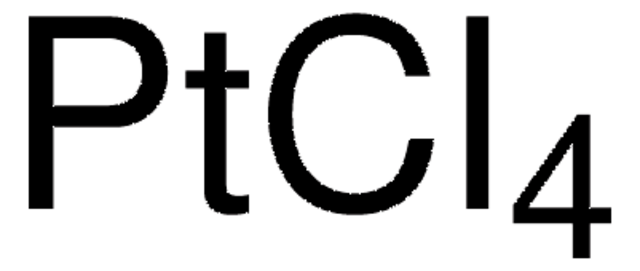206083
Chloroplatinic acid hexahydrate
ACS reagent, ≥37.50% Pt basis
Synonym(s):
Hexachloroplatinic acid hexahydrate, Hydrogen hexachloroplatinate(IV) hexahydrate, Platinic chloride hexahydrate
About This Item
Recommended Products
grade
ACS reagent
Quality Level
form
powder or chunks
reaction suitability
reagent type: catalyst
core: platinum
concentration
≥37.5% Pt
solubility
alcohol: soluble
cation traces
alkalies and other metals: ≤0.05%
SMILES string
O.O.O.O.O.O.Cl.Cl.Cl[Pt](Cl)(Cl)Cl
InChI
1S/6ClH.6H2O.Pt/h6*1H;6*1H2;/q;;;;;;;;;;;;+4/p-4
InChI key
PIJUVEPNGATXOD-UHFFFAOYSA-J
Looking for similar products? Visit Product Comparison Guide
General description
Application
- Preparation of Pd nanocubes (150nm width) and Pt nanospheres (150nm diameter).
- To compose the plating solution for the electrodeposition of Pt nanoparticles on the multilayered graphene petal nanosheets (MGPNs).
- Synthesis of nano-composites of Pt and nano-carbon (NC).3
Signal Word
Danger
Hazard Statements
Precautionary Statements
Hazard Classifications
Acute Tox. 3 Oral - Eye Dam. 1 - Resp. Sens. 1 - Skin Corr. 1B - Skin Sens. 1
Storage Class Code
6.1C - Combustible acute toxic Cat.3 / toxic compounds or compounds which causing chronic effects
WGK
WGK 1
Flash Point(F)
Not applicable
Flash Point(C)
Not applicable
Regulatory Information
Choose from one of the most recent versions:
Already Own This Product?
Find documentation for the products that you have recently purchased in the Document Library.
Our team of scientists has experience in all areas of research including Life Science, Material Science, Chemical Synthesis, Chromatography, Analytical and many others.
Contact Technical Service







